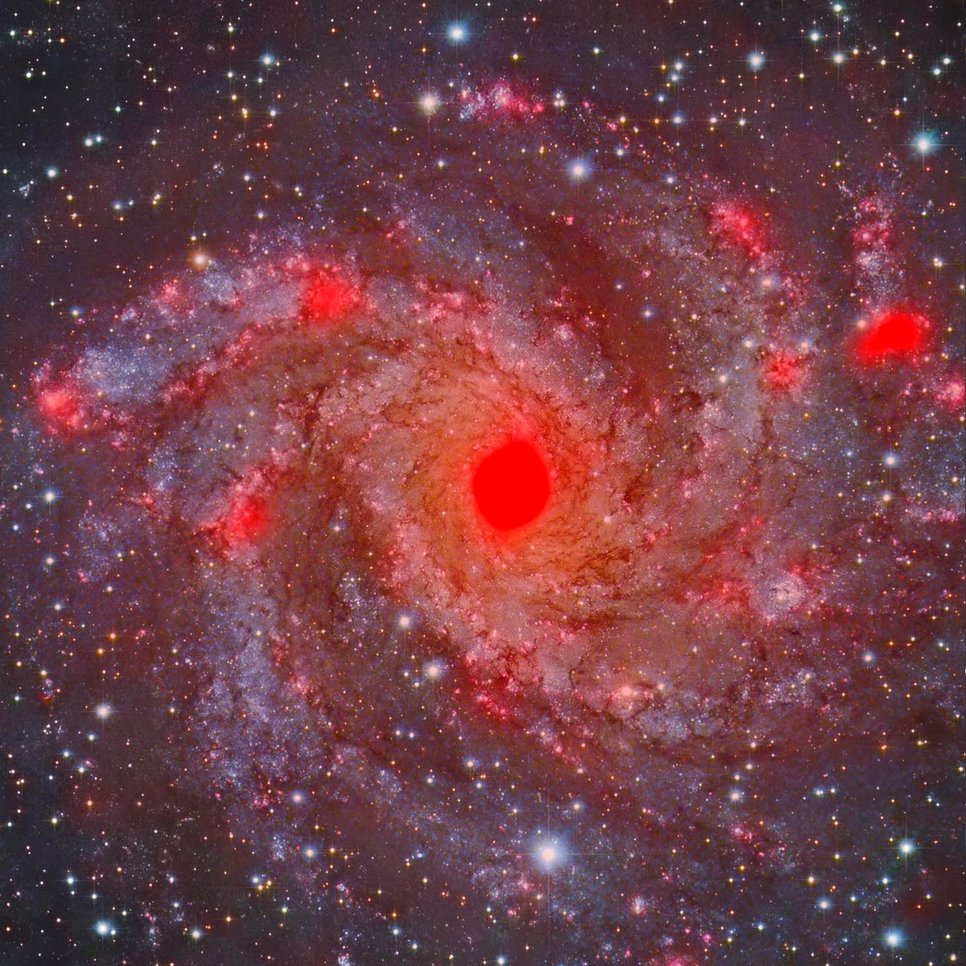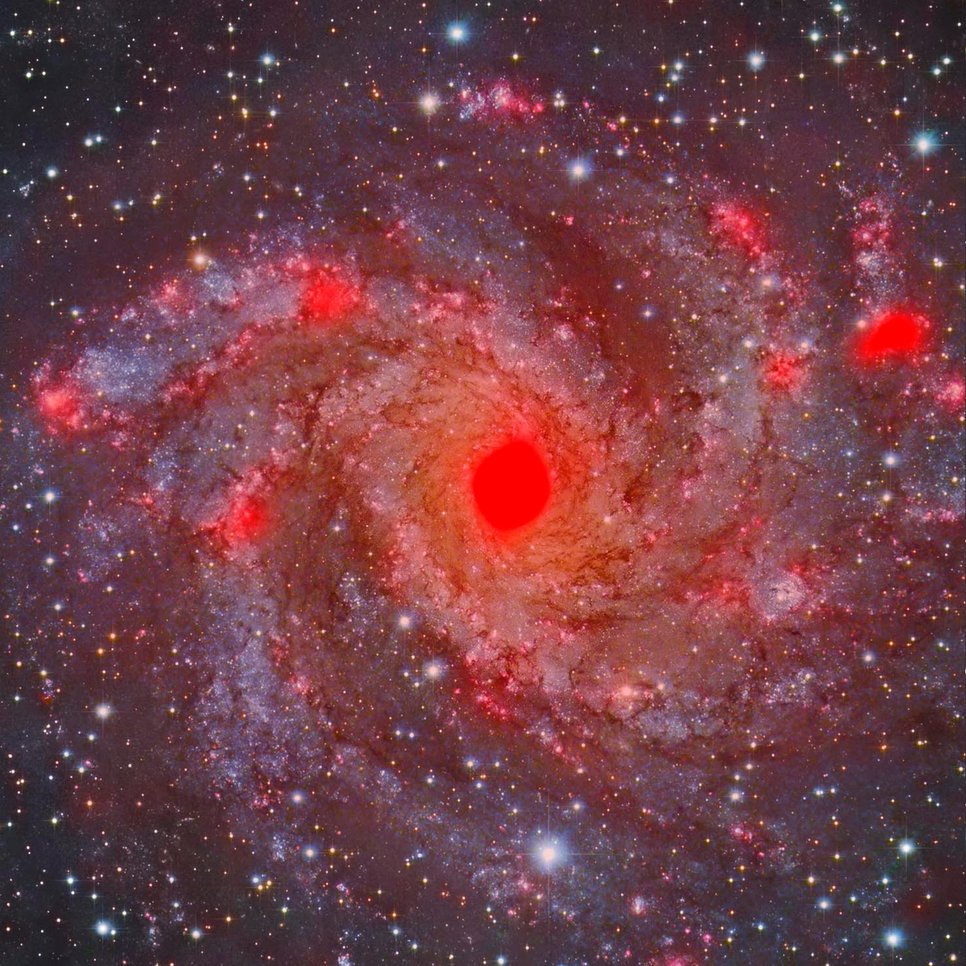Radio astronomers tune in to the star formation channel
Some galaxies produce copious amounts of new stars. Others are less productive. Now, a team of astronomers led by Fatemeh Tabatabaei (Instituto de Astrofisica de Canarias) has developed a method to measure the rate at which galaxies form new stars, using radio observations. The scientists made use of a sample of 52 nearby galaxies that were observed with the Effelsberg 100-m radio telescope at different wavelengths. Star formation rates are a key property of galaxies, and changes in the average star formation rate are an important aspect of the overall evolution of our universe.
| Background information | Download area |

On human time scales, we look upon the stars as permanent and unchanging. But stars change, stars can perish, and in many galaxies, new stars are forming all the time. In fact, a galaxy's star formation rate – the amount of stars forming per unit time, typically measured in multiples of one solar mass per year – is one of its most interesting properties. Understanding the change of star formation rates over the past billions of years, and the reasons behind it, is one of the key challenges facing astronomers interested in the large-scale evolution of our cosmos.
Understanding is built on data. Star formation rates are not easy to measure, given that stars form deep within clouds of gas and dust, invisible to ordinary telescopes. Most current measurements of star formation rates make use of observations in visible light and ultraviolet, combined with infrared observations to account for the amount of radiation absorbed by the dust. But there is still uncertainty about how to best combine these observations to yield an estimate of the star formation rate. Notably, some of the infrared light received from galaxies could come from sources other than young stars heating the dust that surrounds them.
Now, a group of astronomers led by Fatemeh Tabatabaei (Instituto de Astrofisica de Canarias), which includes researchers from the Max Planck Institute for Astronomy and the Max Planck Institute for Radio Astronomy, has found a new way of measuring star formation rates with radio waves – reliably, and particularly suitable for studying the formation of young massive stars.
Star formation via radio waves
The project had grown out of an idea by Eva Schinnerer (Max Planck Institute for Astronomy [MPIA]) and Eric Murphy (National Radio Astronomy Observatory) to establish a more precise measure of the star formation rate for galaxies as follows: The KINGFISH sample is a diverse set of galaxies studied with ESA's Herschel Space Observatory. The star formation rate had been measured in the 61 KINGFISH galaxies by combining Herschel's infrared observations with observations in visible light and in the ultraviolet part of the spectrum. What would those same galaxies look like in the radio part of the spectrum? And might the radio images contain information about star formation rates?
To this end, Schinnerer applied for time at the 100 meter radio telescope in Effelsberg, Germany. In a campaign led by Marita Krause from the Max Planck Institute for Radio Astronomy (MPIfR), this yielded radio data for those 52 galaxies in the KINGFISH sample that are accessible for this particular telescope, which is located in the Northern hemisphere.
Tabatabaei, a postdoctoral researcher at MPIA, then studied in detail the properties and origins of the radio emission from each galaxy. She found that radiation in a certain frequency range, the so-called mid-radio continuum (MRC) between 1 and 10 Gigahertz, is directly related to the formation of young, massive stars. Some of this radiation is created as young stars heat up the surrounding dust, other parts when very massive young stars explode as a supernova shortly after they are born – their early deaths, ironically, another indicator of ongoing star formation. All in all, the radiation can be used to trace the formation of massive stars to galaxies so distant their light needs 100 million years to reach observers here on Earth.
The new method has wide-ranging consequences. Using so-called radio interferometers, it allows for much more detailed maps of star formation than ever before. The radio waves in question are not dimmed by dust, so nascent stars cannot hide. The fact that it involves different phases of star formation – both the radiation from young massive stars and their early death – promises a more robust measure of formation rates. And the fact that only one kind of observation is involved, radio observations in a certain frequency range, makes it easier than before to undertake these measurements in the first place.
In this way, measuring star-formation rates in galaxies has now become faster and more reliable – paving the way for much more complete and deep surveys of star formation rates, and their development over the course of cosmic evolution, using radio telescopes.
Background information
The results described here have been published as F.S. Tabatabaei et al. 2017, "The radio spectral energy distribution and star formation rate calibration in galaxies" in the Astrophysical Journal.
- E-print on the arXiv server: arXiv:1611.01705
- Press release by the Max Planck Institute for Radio Astronomy
The members of the research team are F.S. Tabatabaei (Instituto de Astrof´ısica de Canarias, Universidad de La Laguna and Max Planck Institute for Astronomy [MPIA]), E. Schinnerer (MPIA), M. Krause (Max Planck Institute for Radio Astronomy [MPIfR]), G. Dumas, S. Meidt (both MPIA), A. Damas-Segovia, R. Beck (both MPIfR), E.J. Murphy (NRAO), D.D. Mulcahy (University of Manchester), B. Groves (Australian National University), A. Bolatto (University of Maryland), D. Dale (University of Wyoming), M. Galametz (ESO), K. Sandstrom (University of California, San Diego), M. Boquien (Universidad de Antofagasta), D. Calzetti (University of Massachussetts at Amhurst), R.C. Kennicutt (University of Cambridge), L.K. Hunt (INAF–Osservatorio Astrofisico di Arcetri), I. de Looze (University College London), and E.W. Pellegrini (University of Heidelberg).
Fatemeh Tabatabaei started to investigate the radio and infrared emission of galaxies as part of her PhD thesis at MPIfR, followed by postdoc positions at MPIfR and MPIA. At present she works as an IAC fellow at the Instituto de Astrofisica de Canarias (IAC), Tenerife.
KINGFISH (“Key Insights on Nearby Galaxies: a Far-Infrared Survey with Herschel”) is a survey of 61 galaxies in the nearby Universe. KINGFISHER (“KINGFISH galaxies Emitting in Radio”) provides a subsample of these galaxies north of -21 degrees declination. For 17 of these galaxies radio data from the Effelsberg 100-m radio telescope at different frequencies did already exist, and 35 galaxies were newly observed with the Effelsberg telescope. Both data sets with a total of 52 galaxies were used for the present study.
Additional figures and download


